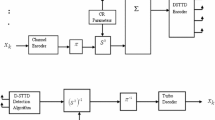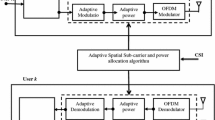Abstract
In cellular mobile communication systems using coded modulations, the spectrum efficiency of the system is related to the number of available codes. Recently, large area synchronous (LAS) CDMA codes, which exhibit a region called interference free window (IFW) within some delay-spread, have been accepted as one of fourth-generation (4G) wireless communication systems. However, the number of synthesized LAS codes is very low due to the low duty ratio of the sequence. In this paper, a dynamic space coded multiple access (DSCMA) scheme which utilizes the spatial diversity from smart antenna system is proposed to overcome the low spectrum efficiency in LAS CDMA system. In the DSCMA a modified version of LAS codes called LAS even ternary (LAS-ET) codes is proposed. These codes are used together with a novel algorithm called dynamic space code (DSC), which will decrease the code length so that the spectrum efficiency can be increased. By taking advantage of dynamic code reuse assignment in spatial diversity, the spectrum efficiency of the DSCMA can be further increased significantly.
Similar content being viewed by others
References
Lu W.W. (2003) 4G mobile research in Asia. IEEE Communications Magazine 41(3): 104–106 March 2003
Yu J., Yao Y.D., Zhang J. (2004) Reverse-link capacity of power-controlled CDMA systems with beamforming. IEEE Transactions on Vehicular Technology 53(5): 1423–1433 September 2004
Sirbu, M., & Koivunen, V. (2002). Channel estimation and tracking in asynchronous uplink DS/CDMA using multiple antenna. Fourteenth international conference on digital signal (DSP 2002) Processing, Vol. 2 (pp. 635–638), July 1–3, 2002.
Wei H., Yang L., Hanzo L. (2005) Interference-free broadband single and multicarrier DS-CDMA. IEEE Communications Magazine 43(2): 68–73 Feburary 2005
Li D. (2003) The Perspectives of Large Area Synchronous CDMA Technology for the Fourth-Generation Mobile Radio. IEEE Communications Magazine 41(3): 114–118 March 2003
Li, D. (1999). A high spectrum efficient multiple access code. Fifth Asia-Pacific Conference on Communications and Fourth Optoelectronics and Communications Conference (APCC/OECC ‘99), Vol. 1, (pp. 598–605), October 18–22, 1999.
Choi, B. J., & Hanzo, L. (2002). On the design of LAS spreading codes. IEEE 56th vehicular technology conference (VTC 2002-fall) proceedings, Vol. 4, (pp. 2172–2176), September 24–28, 2002.
Author information
Authors and Affiliations
Corresponding author
Rights and permissions
About this article
Cite this article
Ng, C.K., Noordin, N.K., Ali, B.M. et al. Spectrum Efficiency Enhancement in Dynamic Space Coded Multiple Access (DSCMA) System. Wireless Pers Commun 53, 253–267 (2010). https://doi.org/10.1007/s11277-009-9682-7
Received:
Accepted:
Published:
Issue Date:
DOI: https://doi.org/10.1007/s11277-009-9682-7




